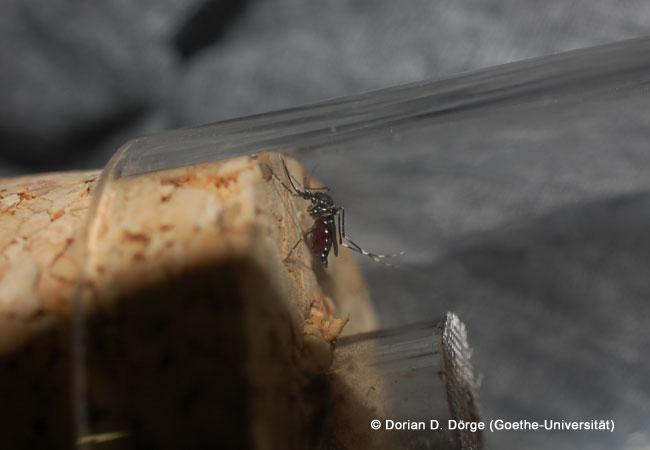Scientists from Goethe University and Senckenberg Society for Nature Research are developing maps on the Zika virus infection risk

Credit: Dorian D. Dörge, Goethe University
FRANKFURT. The spread of infectious diseases such as Zika depends on many different factors. Environmental factors play a role, as do socioeconomic factors. Recently, several attempts have be made to predict the transmission risk of the Zika virus at a global and local level, but the spatial and temporal patterns of transmission are still not well understood. Researchers from Goethe University and the Senckenberg Society for Nature Research in Frankfurt were now able to generate reliable maps for the transmission risk of the Zika virus in South America. The results have been published in the scientific journal PeerJ. Based on the models for South America, they will use the method to determine the Zika risk for Europe as well.
In most cases, mosquitoes of the genus Aedes transmit the Zika virus to humans. Primary vectors are the yellow fever mosquito (Aedes aegypti) and the Asian tiger mosquito (Aedes albopictus). Both mosquito species are widespread in South America. Whereas the yellow fever mosquito (Aedes albopictus) is nearly absent in Europe, the Asian tiger mosquito is widespread in the Mediterranean region.
“With our new modelling approaches we can illustrate the risk areas for Zika infections in Latin America,” says Sven Klimpel Professor for Parasitology and Infection Biology at Goethe University in Frankfurt and the Senckenberg Biodiversity and Climate Research Centre. “The models additionally allow us to illustrate Zika risk areas for Europe. For example, our models indicate the two autochthonous cases in southern France in Département Var (see illustration).” At the end of October, French authorities announced the first Zika case in Europe; about a week later, a second case was made public.
According to the researcher’s calculations, the Zika infection risk in South America is highest along the Brazilian East Coast and in Central America. The risk is moderate in the Amazon region and lowest in the southern areas of the continent. The following countries are especially affected according to the model: Brazil, Columbia, Cuba, the Dominican Republic, El Salvador, Guatemala, Haiti, Honduras, Jamaica, Mexico, Puerto Rico and Venezuela. In Europe, a risk of infection exists mainly in the Mediterranean region, but also in the inland regions of France and in the Rhine areas of Baden-Württemberg.
To determine the infection risk of a specific area, the researchers Dr Sarah Cunze and Professor Sven Klimpel modelled the potential spread of the two species of mosquito, Aedes aegypti and Aedes albopictus. Since the mosquitoes can only transmit the Zika virus in regions where the virus is present in the first place, the researchers included an Evidence Consensus Map in their risk model. This map categorises the number of reported Zika illnesses at the regional level. The average temperature of the warmest quarter was also incorporated in the model, since temperature has a significant influence on whether the virus can survive and multiply in the mosquito. Finally, the scientists added socioeconomic factors such as population density and gross domestic product to their risk model
###
Publication: Cunze S, Kochmann J, Koch LK, Genthner E, Klimpel S. 2019. Vector distribution and transmission risk of the Zika virus in South and Central America. PeerJ 7:e7920 DOI 10.7717/peerj.7920
An image maybe downloaded here: http://www.
Captions:
Illustration 1: Correlative modelling approach for regions with increased Zika infection risk in South America. In addition to the modelled expansion of the two main vector types (Aedes aegypti a1 and Ae. albopictus a2), the model incorporates the average temperature of the warmest quarter (b), the occurrence of the Zika virus (c) and the Dengue virus (e), population density (f) and the gross domestic product.
Illustration 2: Zika infection risk modelled for South America.
Illustration 3: Regions where an autochthonous transmission of the Zika virus through the bite of an infected tiger mosquito is possible, since the temperature conditions are suitable (red areas) and the tiger mosquito is already present as vector species (hatched areas).
Further information: Professor Sven Klimpel, Institute for Ecology, Evolution and Diversity, Faculty 15 (Biosciences), Riedberg Campus, phone +49 69 798-42237, E-Mail [email protected]
Current news about science, teaching, and society can be found on GOETHE-UNI online (http://www.
Goethe University is a research-oriented university in the European financial centre Frankfurt am Main. The university was founded in 1914 through private funding, primarily from Jewish sponsors, and has since produced pioneering achievements in the areas of social sciences, sociology and economics, medicine, quantum physics, brain research, and labour law. It gained a unique level of autonomy on 1 January 2008 by returning to its historic roots as a “foundation university”. Today, it is one of the three largest universities in Germany. Together with the Technical University of Darmstadt and the University of Mainz, it is a partner in the inter-state strategic Rhine-Main University Alliance. Internet: http://www.
Publisher: The President of Goethe University Editor: Dr. Anke Sauter, Science and Humanities Editor, International Communication, PR & Communication Department, Theodor-W.-Adorno-Platz 1, 60323 Frankfurt am Main, Tel: +49(0)69 798-13066, Fax +49(0)69 798-761 12531, [email protected].
Media Contact
Sven Klimpel
[email protected]
49-697-984-2237
Original Source
https:/
Related Journal Article
http://dx.




